Foundation Projects
Eight small-scale Foundation Projects ran between 1 February 2020 and 2022.
The Foundation Projects helped are helping us generate evidence and policy recommendations to inform the future development of the UK future of the infrastructure of digital collections. The projects laid the foundations for a UK-wide digital collection by identifying and addressing the current or future challenges facing its formation. Each project is a collaboration between at least one Independent Research Organisation (IRO) and one Higher Education Institution and includes relevant non-IRO organisations.
All projects have now been finished and have now published their Final Reports. The eight reports make recommendations for the further development of the Digital Humanities landscape in the UK.
Projects
Heritage Connector
PI: John Stack (Science Museum Group)
Co-Is: Jane Winters (University of London), Jamie Unwin (Science Museum Group) & Angela Wolff (V&A)
Final Report
Website Interim Report
More Information
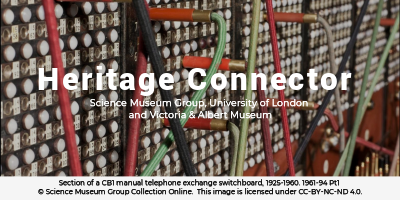
As with almost all data, museum collection catalogues are largely unstructured, variable in consistency and overwhelmingly composed of thin records. This is largely a legacy of the development of these catalogues from handwritten paper records. The depth and form of collection catalogues have been primarily guided by collection management needs (records of acquisition, administration of loans, provenance documentation, etc.) where unstructured data can fulfil the needs of the organisation and comply with collection management standards.
When computer technology was adopted for collection management in the 1980s it was implemented to handle these same back-office tasks rather than to support public access. The resulting form of the catalogues means that the potential for new forms of digital research, access and scholarly enquiry remain dormant, and searching across collections is currently possible only through aggregation which is labour-intensive to implement, or by third-party search engines where results are unreliable.
In this project, we will apply a battery of digital techniques to connect similar, identical and related items within and across collections. Our primary research question is "How can existing digital tools and methods be used to build relationships at scale between poorly and inconsistently catalogued digitised collection objects and other content sources?"
Since the turn of the twenty-first century enormous and growing volumes of material have been digitised, and catalogues have begun to address the needs of digital public access. However, this has been mainly at an institutional level or via a handful of content aggregators and thus the enhancement of catalogues for the purposes of public access has been driven by the needs of individual collection websites, with little or no interlinking to other collections or content sources. Where that linking (people, places, events, objects, etc.) does exist it has been undertaken by human intervention, and because of the number of records, it has been limited in scale and scope and rarely an ongoing endeavour despite the evolving nature of the catalogue.
Alongside the digitisation of collections, recent years have seen a growth in the publication online of scholarly research related to heritage collections: open access journals, theses, and other online resources. However, beyond the host institution, references to this material is rarely, if ever, ingested into the underlying collections systems and made available via links from related collection websites. This project will therefore also use computer analysis to attempt to identify and build links to this material.
Finally, structured data and rich linking are an increasingly urgent concern as new forms of discovery and access emerge - notably artificial intelligence powered discovery and new interfaces such as voice search - that rely on these for their functionality. This project will explore an alternative approach - a "Heritage Connection Engine" - that will analyse catalogues, published material and knowledge graphs, and build links at massive scale between these that can then be used for new forms of research.
It will explore the opportunity for computer generated links with Wikidata to provide new levels of structure and machine-readable data that can form the foundation of new types of discovery and access. The "Heritage Connection Engine" will use a range of technologies including machine learning; named entity recognition; open data; and persistent IDs. These methods will create a large-scale data source of links, each with a confidence ranking. Computational enquiry to generated links via an application programming interface (API) will enable the creation of a range of proof-of-concept research and discovery tools. All software will be documented released under an open source Licence. All datasets will be released under the Creative Commons Zero license.
Provisional Semantics
PI: Emily Pringle (Tate)
Co-Is: Helen Mavin (IWM), Tate Greenhaigh (National Trust), Anjalie Dalal-Clayton (University of the Arts London)
Final Report
Website Interim Report
More Information
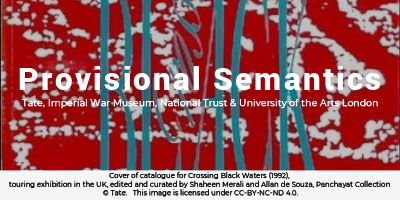
Provisional semantics addresses a fundamental challenge facing the Towards a National Collection programme: how to develop ethical, equitable and transparent readings to support a more diverse public to engage with the digitised national collection. Currently, many subject index terms, catalogue entries and associated captions of artworks, visual media and artefacts have been informed by colonial contexts, attitudes and modes of perception. These can therefore be outdated and/or offensive to present day audiences, not least people of African and Asian descent in the UK, whose diasporic histories are intertwined with Britain's colonial and imperial past. Outdated and offensive language and interpretation deters engagement by the very audiences that collections seek to attract.
Many in the heritage sector recognise the need to interrogate and redress problematic language and representations and there is a drive to decolonise - that is to explore and undo fundamental relationships of power and inequity, and to diversify - that is to present multiple perspectives. Yet at present the lack of research examining what is required in terms of ethical methodologies and practical and attitudinal shifts prevents sustainable change from taking place. Provisional semantics seeks to address this challenge by (1) examining what methodological, ethical and practical changes heritage organisations need to make to accommodate the multiple and provisional interpretations necessary for a sustainable digitised national collection to genuinely represent UK Heritage. And (2) testing what methods and approaches that engage intellectually and practically with the decolonial agenda can heritage organisations employ to produce search terms/catalogue entries and interpretations fit for purpose for an evolving digitised national collection.
Over 18 months the project will undertake a wide-ranging literature and practice review and utilise three case studies centred on specific collections at The National Trust, Imperial War Museum and Tate that address the histories, representations and artistic practices of people of African and Asian descent. Each case study will test a different approach to collaborating with key stakeholders of each collection whose expertise as people of African and Asian descent can help provide more equitable, multi-perspectival interpretations. This research will be further enhanced by a close reading of sample texts from each collection undertaken by our academic partner, Dr Anjalie Dalal-Clayton, whose research focuses on arts and decolonisation in museums, collections and heritage organisations.
In addition to the case studies and close readings, the main output will be a state of the art report that brings together the findings from the research, outlines the key challenges and provides evidence-based recommendations. These recommendations will have been tested with a group of interdisciplinary experts and disseminated to a wider group of heritage organisation professionals, academics and representatives from the standards agencies via 'sense-checking' workshops, events linked to the wider programme, journal articles, social media and through the project webpages that will be maintained on the Tate website.
Through piloting methodologies Provisional Semantics will contribute new knowledge and directly support heritage organisations seeking to decolonise and diversify their collections as an embedded strategy towards developing a genuinely representative digitised national collection. The research aims to meet the needs of academics, standards agencies, heritage professionals, policy makers and the wider public. Importantly, Provisional Semantics will have wider benefits in terms of reshaping how key stakeholders of African and Asian descent can actively participate in forming the narratives of UK Heritage.
Practical Applications of IIIF
PI: Joseph Padfield (The National Gallery)
Co-Is: Torsten Reimer (British Library), Charlotte Bolland (The National Portait Gallery), Melissa Terras (University of Edinburgh)
Final Report
Website Interim Report
More Information
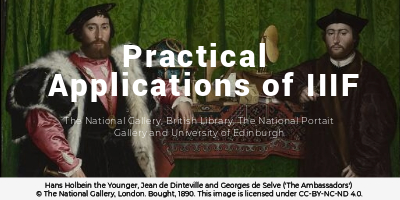
Even more than text, images are critical in engaging (digital) audiences with cultural heritage, to illustrate stories, present collections, explore old manuscripts and documents, or illuminate colourful parts of our history. Presenting or sharing small groups of images is technologically straightforward, but as the quality, size and quantity of images increase, implementation and delivery rapidly becomes more complicated. For example, it can be problematic and costly to download gigabyte-sized images on a mobile network. The complexity increases as users combine images from different institutions or countries. There are also many IPR and technological concerns when memory institutions are asked to provide high resolution copies of their images for collaborative projects.
The International Image Interoperability Framework (IIIF) continues to be developed to help solve these and many more issues. It provides a standard framework for institutions to present their own content in a consistent, trackable manner, using freely available software. IIIF resources from multiple institutions can be virtually combined (without sending images to each other) to provide shared presentations, allowing users to explore huge zoomable images on different devices without needing to copy or download whole images.
However, though well described, setting up and re-using IIIF resources can still be complex, particularly for smaller institutions or individual researchers. In addition, better understanding of how to deploy IIIF to combine virtual collections across institutions and how to support more diverse audiences is needed. This research project will assess current use of IIIF systems across the sector and gather requirements and ambitions for further development via a series of targeted workshops and surveys. These will be used to produce a landscape report and to inform the design and development of a small selection of working IIIF technology pilot demonstrations.
A: Working with and presenting datasets and research outputs from different institutions, focusing on resources created within a separate ongoing research project on Tudor/Jacobean portraits.
B: Examining how IIIF resources can be used as supplementary information to support and enrich online publications or exhibitions.
C: Demonstrating how individual non-technical researchers can create new aggregated IIIF presentations based on existing resources (overcoming a significant barrier to its adoption).
This work will involve specific user analysis, with different potential use communities, in order to feed user needs and feedback into the resulting report. The project will also explore what new IIIF tools/services are needed in the sector and how they might be created, used and maintained. An important premise is to involve both tech and non tech people, to develop use cases as well as defining tools.
Persistent Identifiers
PI: Rachael Kotarski (The British Library)
Co-Is: Lorna Mitchell (Royal Botantic Garden Edinburgh), Roderic Page (University of Glasgow), Joseph Padfield (The National Gallery)
Final Report
GitHub Page Interim Report
More Information
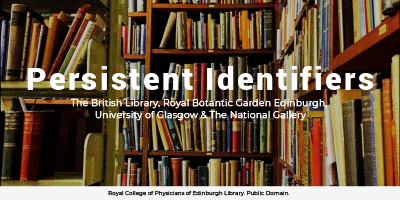
The 2,500 museums, heritage collections and heritage sites in the UK house at least 200 million physical and digital objects. Being able to uniquely identify these objects is key to facilitating their use and curation - you cannot provide a researcher with access to an item or include it in an exhibition if you don't know what it is. Unique accession numbers are therefore a key component in all collection and library management systems but these only include the objects within an individual collection. To fully realise the potential benefits of our national collections in terms of the social and cultural life of the UK, the economic impact of the heritage sector, and the contribution to the UK's international prestige and influence, we need identifiers that will bring together all of the objects from all of the collections.
Persistent Identifiers (PIDs) that provide a long-lasting actionable reference to a digital object are recognised by UKRI as a key component of future research infrastructure enabling data discovery, access and citation. Facilitating wider adoption and consistency of approach to the assigning of PIDs to collection objects, environments, specimens and other relevant entities, is a key step to the persistent, unambiguous linking of collections in order to create a digital UK National Collection. However, the challenges, utility and wider benefits of PID implementation are less well understood across the heritage sector.
While many individual institutions are using PIDs to a greater or lesser extent, to date there has been very little cross-sector or cross-collection collaboration and / or support to facilitate a cohesive approach that will maximise the benefits to all organisations. This foundation project will bring together best practices in the use of PIDs from a collection perspective, building on existing IRO work and expertise developed through existing research projects. By sharing expertise and best practice, we will provide a framework and recommendations on the approach to PIDs for colleagues in local, regional and national institutions across the UK heritage sector. Through a mixture of workshops, desk research and case studies, the project will seek to answer questions such as 'What are the gaps in the existing PID landscape for heritage collections, buildings and environments?' and 'What should a PID infrastructure, strategy and governance framework look like for a unified UK national collection?'. The project will deliver a set of recommendations to guide the selection, implementation and use of PIDs to heritage collections and related entities and concepts, as well as a number of case studies and supporting resources that can be used across the sector as a guide to real-world PID implementation.
In driving the use of PIDs for heritage collections, the project will enable greater use of these collections in all contexts, but especially in research. It will allow improved linking across platforms such as Wikidata, making it easier to associate related concepts and metadata with canonical sources of artefact information and the artefacts themselves. It will provide for the curation and selection of this information from diverse sources to be displayed alongside artefacts in physical spaces and online viewers. Importantly, they will also make this increase in use more evident and measurable, through the improved metrics that PIDs support.
Deep Discoveries
PI: Lora Angelova (The National Archives)
Co-Is: Pip Willcox (The National Archives), John Collomosse (University of Surrey), Joanna Norman (Victoria & Albert Museum), Robert Cubey (Royal Botanic Garden Edinburgh)
Final Report
Website Interim Report
More Information
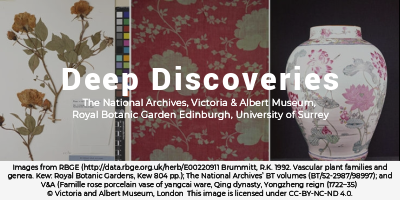
Couched in a network of research initiatives under the umbrella theme 'Towards a National Collection: Opening UK Heritage to the World', the Deep Discoveries project aims to contribute to the creation of a unified national heritage collection by creating a transformative image searching platform. Our goal is to design a prototype app enabling cross-collection image linking by harnessing the ability of computer vision and deep learning methods to identify and recognise specific patterns without the need for preliminary integrated descriptive metadata. The project aims to create a radical shift in content discovery within and between our nation's digitised image repositories, allowing users the opportunity to dissolve established physical and virtual barriers between these collections, opening cross-disciplinary modes of research and engagement and generating new and unforeseen connections leading to user-generated, disruptive, and (re)defined notions of 'national' heritage.
Through employing the catalytic potential of ever more socially-integrated artificial intelligence (AI) technologies for the benefit of opening up our national heritage collections and radically diversifying our visitor base, the project will ensure that these tools are directed toward the enhancement of the heritage economy and the wider social good.
Crucially, the nature of deep learning architectures future-proofs the search platform, as it will be able to evolve and improve as the underpinning dataset grows. If successful, the creation of an image search platform able to continuously integrate new digital image repositories as they are generated by GLAM-sector organisations will have enormous benefits in making collections networked and openly discoverable across our virtual heritage landscape. Such an advancement will demonstrate the UK's commitment to cutting-edge technologies and shift the view of the museum/archive from a historical repository to a space of dynamic and emergent practices, inviting diverse users to weave new narratives from our collections.
To achieve our ambitious goals, we have formed a cross-disciplinary network of diverse institutional partners: the core team is formed by researchers from the University of Surrey's Centre for Vision Speech and Signal Processing, the Collection Care and Research departments of The National Archives, the Royal Botanical Gardens Edinburgh, and the V&A Research Institute. We are also joined by three Project Partners who will support the project through offering access to parts of their digitised image collections. Our partners include Gainsborough Weaving Studio, the Sanderson Design Archive, and the Museum of Domestic Design and Architecture. We will work together through a series of workshops, some of which will be jointly held with other projects from the Towards a National Collection programme. By surveying the current landscape of digital image users and working with a variety of stakeholders (public, academic, institutional) we will work to iteratively design a visual search platform that truly Opens up UK Heritage to the World.
Engaging Crowds
PI: Pip Willcox (The National Archives)
Co-Is: Christopher Lintott (University of Oxford), Elspeth Haston (Royal Botanic Garden Edinburgh), Martin Samon (National Maritime Museum
Final Report
Website Interim Report
More Information
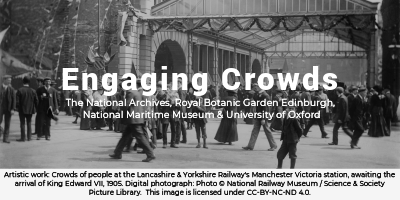
Public participation in heritage research has the potential to engage new audiences, to enlist the crowd in analysing and generating data at scale, and to invite new perspectives on our national collections. Key to releasing this potential is effective engagement of diverse audiences, and the development of workflows for the creation and re-use of data within collection discovery platforms, for training automated systems, and to give access to the citizens and researchers. We will identify ways of extending and deepening engagement across communities, proposing a best-practice framework for future citizen research projects with heritage data, informing their design and modelling.
Citizen research and automation are two complementary methods for capturing and describing our increasing quantities of analogue, digital and digitised data. We propose articulating the synergies between them by developing workflows for the re-use of data beyond projects' initial focuses to provide current and future scholarship with the potential to address new research questions. Led by three IROs with significant experience of citizen research, Royal Botanic Gardens Edinburgh (RBGE), Royal Museums Greenwich (RMG) and The National Archives (TNA), and the world-leading citizen research expertise of the University of Oxford's Zooniverse with its distinctive free, open source infrastructure, community of 1.9 million volunteers worldwide, and technical expertise of having delivered over 190 crowdsourcing projects, this project is uniquely placed to research and prototype tools for deeper engagement with our collections through citizen research: to create a virtuous circle of increased and better informed public engagement that leads communities to create more collections data at scale. The project will convene expertise from across sectors to expand our citizen research community and to ensure the effective re-use of crowd-sourced data. This will be achieved by addressing the following questions:
1. How can we best engage volunteers across the nation's communities with citizen research projects, to further a shared understanding of our collections? What existing methods and data are the most successful for measuring that engagement? 2. How does the ability to navigate one's own path through the data of a citizen research project affect engagement with the project? 3. How can we verify, assess, present, and value the contributions of citizen research? 4. How can we enable the re-use of crowd-sourced data within collection discovery platforms, for training automated systems, and to give access to citizens and researchers that supports and encourages further engagement, re-use and analysis? 5. Does easy access to data created by citizen research projects affect engagement with projects? What other tools are necessary to enable meaningful access to this data?"
Locating a National Collection
PI: Gethin Rees (British Library)
Co-Is: Leif Isaksen (University of Exeter), Alex Hunt (The National Trust), Anthony Musson (Historic Royal Palaces)
Final Report
Website Interim Report
More Information

This project will help cultural heritage organisations to use geospatial data - references and representations of location, such as where objects were made and used or the places they depict and describe - to connect diverse collections and engage research and public audiences in new ways. Through scoping, workshops and audience research the project will establish best practice and provide technical recommendations for the development of a national discovery system whereby objects about a topic of interest can be readily discovered from a variety of sources, represented in the context of their historic environment, and referenced in time and landscape.
At present, discovering collections across multiple institutions and collections can be problematic in terms of user experience, requiring complex text-box searches or commercial search engines. However, in the field of Classics, The Pelagios Network of researchers, scientists and curators has developed a methodology that uses gazetteer referencing to link research data across diverse collections with considerable success, building a community of partners and stimulating new research perspectives. Similarly, the Collections Trust's prototype aggregator demonstrates that searching across cultural heritage collections using geographic location is feasible. This project builds on these methods, scoping improvements to the aggregator's results and exploring ways to present location in an accessible and meaningful form for public consumption.
A key question is how the place-based Pelagios methodology can best be integrated with space-based cultural heritage data resources brought together by the Collections Trust aggregator. To test and scope this ambition, participating organisations will work on a set of thematic and technological case studies that will test the technical feasibility and appeal of the approach to potential users, ultimately developing an understanding of scalability.
The project aims to understand the requirements of stakeholders, institutional, academic and public, in order to inform content selection, technical decisions and maximise impact. It will investigate how we can use location to build a common infrastructure that links collections and render this content accessible and meaningful to different audiences. The objective is to understand the technical components required, the current and potential options available and to make recommendations for potential solutions, all of which will be described in the project report. The report will constitute a strategy, offering pathways for progress and outlining potential barriers to inform developments in the next phase of Towards a National Collection and across the cultural heritage sector more broadly. It will encourage cultural heritage organisations to take up a common geospatial approach and will provide a roadmap to enable diverse organisations to enrich their metadata and expose this in a consistent and joined-up way.
Pelagios has had success with a decentralised, 'opt-in' model of partner engagement. Our project will explore whether distributed or centralised models of integration and cooperation are relevant to the integration of cultural heritage organisations. It will develop understanding within the cultural heritage sector of how location-based interfaces can be used to make collections meaningful, spear-heading a movement beyond text-based searches in the discovery of content. Location offers an exemplar, offering a common thread from which we can learn about wider opportunities in connecting collections using other commonalities such as person, time or subject.
Preserving and Sharing Born Digital and Hybrid Objects
PI: Natalie Kane (Victoria & Albert Museum)
Co-Is: Joel McKim (Birkbeck College), Richard Palmer (Victoria & Albert Museum), Stephen McConnachie (British Film Institute)
Final Report
Website Interim Report
More Information
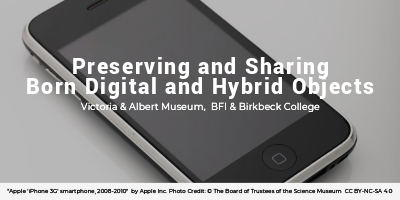
As part of a set of foundational research projects under the theme 'Towards a National Collection: Opening UK Heritage to the World', the Preserving and Sharing Born-digital and Hybrid Objects project aims to contribute to the creation of a unified national heritage collection that includes born-digital cultural heritage.
Contemporary culture is increasingly digital. From websites, applications and social media, to digital film, to digital artworks and design tools, creative practitioners in a range of fields are increasingly working with digital or hybrid physical-digital skills. However, this prevalence of digital culture poses a significant challenge to collecting organisations which are responsible for acquiring, preserving and making culture available to the public, now and in the future. In considering how to make our national collections accessible to the world, we must consider born-digital and hybrid material as an increasingly important part of those collections, otherwise we risk failing to preserve the vast majority of our contemporary culture for future generations and entirely omitting this important part of our culture from initiatives to make that culture accessible as widely and as meaningfully as possible.
This project seeks to address the challenges of born-digital and hybrid collections by bringing together expertise in a range of different digital cultural types - from archival and library material to film and complex digital design. It will focus on three specific and shared challenges: collections management - the policies, governance, systems and standards needed to support digital collections; digital preservation and conservation - the skills, software and hardware needed to preserve it for the future; and meaningful access and experience - the development of modes of access that do not merely represent digital culture as static, but 'live' as we experience it. It will involve a combination of desk-based research, reviewing and producing reports on current practices, a series of workshops, and the development of two technical pilots. Collectively this research and these outputs will lay the foundations for the future major research initiatives needed to take this forward on a sector-wide scale.
The research will be undertaken through an interdisciplinary team of academic and collections-based researchers including representatives from the V&A, BFI, Tate, British Library and Birkbeck, University of London. It will also draw in a number of key industry professionals and will bring national and international participants to a series of workshops that will both involve knowledge sharing and will identify recommendations needed to preserve and make accessible born-digital cultural heritage.
By harnessing the collective skills, knowledge and challenges of individuals and institutions involved with different types of born-digital and hybrid cultural heritage, the research project will ensure that born-digital culture remains an integral and research-led part of the national collections of cultural heritage. It will also identify and respond to the need for the development of digital skills and literacy across the cultural sector, so identifying future needs and laying the foundations that are needed in order to truly and inclusively open up the UK's national collections to the world.
